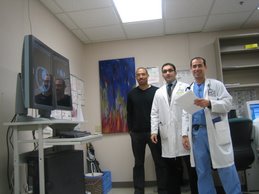Vascular malformations
1-AVM(Arteriovenous malformations)
2-Cavernous hemangiomas
3-Venous angiomas
4-Capillary telangiectasias

Arteriovenous malformations
Definition:represent an aberrant connection between the arterial and venous circulation with bypass of the capillary system .
AVM
This network of abnormal connections represents the "nidus"
AVM
Feeding arteries in the arteriovenous malformation consist of a high blood flow due to low resistance within the arteriovenous malformation.(no capillaries)
low resistance is thought to result in ischemic events, or the Steal phenomenon.
Steal phenomenon
Shunting of blood away from a nervous system location causing transient or persistent ischemia or infarction.
Yamada S, Cojocaru T. Arteriovenous malformations. In: Wood JH, editor. Cerebral blood flow: physiologic and clinical aspects. New York: McGraw-Hill, 1987:580-90.
Hoffman WE. Brain tissue oxygenation in patients with cerebral occlusive disease and arteriovenous malformations. Br J Anaesth 1997 Feb;78(2):169-71.
AVM
Etiology:
Most often these malformations are due to congenital anomalies
Other etiologic include
trauma
radiation.
AVM
Time course-Location:
Arteriovenous malformations evolve slowly over many years and can occur in any location
most often in MCA distribution and in the parietal or frontal lobes.
AVM
Female-male
Commonly present in 2nd and 3rd decade
tangle of dilated veins, filled with arterialized blood ("red veins") is evident, as is hyperemia of the cortical surface
AVM
Hemosiderin deposits :
Adjacent to the AVM can frequently be observed, even in patients who have no history of hemorrhage, indicating that blood leakage is common.
fibromuscular dysplasia and thrombosis
Clinical manifestations
most common presentation for AVM ?
?
3 cm
Hemorrhage typically occurs in arteriovenous malformations <>3 cm
AVM AND HEMORRHAGE
AVM and hemorrhage
Risk of hemorrhage in patients diagnosed with arteriovenous malformations who have not had a previous hemorrhage is in the range of 1.3% to 3.9% yearly
53% of patients with arteriovenous malformations will experience a hemorrhage
Hofmeister C, Stapf C, Hartmann, Stroke 2000 Jun;31(6):1307-10. Demographic, morphological, and clinical characteristics of 1289 patients with brain arteriovenous malformation.
AVM and hemorrhage
SAH
intraparenchymal
Small leaks (hemosiderin deposits)
Factors that Contribute to Increased Risk of Hemorrhage from an Arteriovenous Malformation
Clinical factors
History of hypertension
History of previous hemorrhage
Factors that Contribute to Increased Risk of Hemorrhage from an Arteriovenous Malformation
AVM and hemorrhage
Comparison of Risk Factors and Annual Risk of Hemorrhage Stroke 1996 Jan;27(1):1-6
AVM AND SEIZURE
3 cm
Seizures typically accompany arteriovenous malformations >3 cm
hemorrhage typically occurs in arteriovenous malformations <>6cm 3p
Eloquence of location,1p noneloquence 0
Deep Venous drainage present 1
Grades 1 to 3 are typically treated with microsurgery
Unruptured AVM
Higher grades AVM are more challenging and require multidisciplinary approach for treatment .
Embolization (not used grade1-3)
Stereotactic radiosurgery
SEIZURE
Treatment of lesions presenting with seizures includes surgical resection, embolization, radiosurgery, and anticonvulsant therapy.
SEIZURE
3 year minimum follow-up who had AVM and preoperative seizures, revealed
83% of patients who underwent AVM resection were seizure free (with 48% no longer receiving anticonvulsant therapy),
17% still suffered intermittent seizures
Seizure outcome in patients with surgically treated cerebral arteriovenous malformations. Piepgras , J Neurosurg 1993 Jan;78(1):5-11
Bradly: Ogilvy et al 2001,succ
AVM and Pregnancy
?
AVM and Pregnancy
Bradely:
ICH by AVM is as common as ICH with aneurysems
Time dosen’t always correlate with peak cardiovascular changes
Labor is highest risk period
Descision about Tx should be base on Neurosurgical rather Obstetric criteia
AVM and Pregnancy
Bradley:
Risk of rebreeding is higher in pregnancy
Elective cesarean section may carry the lowest risk
Cavernous hemangiomas
seizure is the most common presentation (in contrast in AVM hemorrhage)38% to 100% of patients
Focal neurologic deficits are the second most common clinical manifestation and have been reported to present in 15.4% to 46.6% of patients.
The incidence of hemorrhage has been estimated from a low of 0.1% to 1.1%
Venous angiomas
Seizures are the most common type of presentation in venous angiomas.
The overall rate of bleeding in venous angiomas has been reported to be between 1% and 16%
Infratentorial and deeply draining supratentorial have a higher incidence of hemorrhage and rebleeding than do superficial supratentorial venous angiomas
Venous angiomas most often occur in the subcortical areas of the frontal lobe or cerebellum

